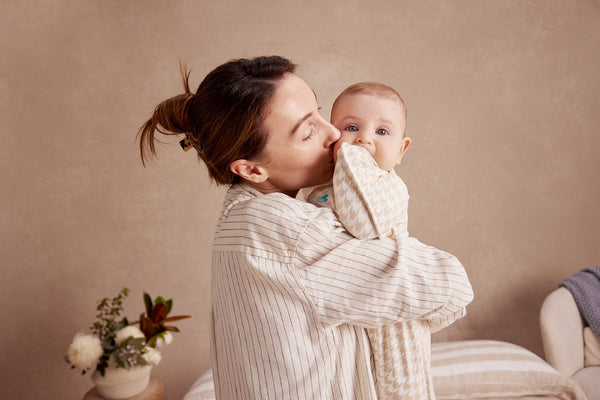Safety first
Always follow safe sleep guidelines. First Candle recommends removing any loose objects from your child’s crib/bassinet before sleep.
Sleep aids such as blankets, pillows, toys etc. should never be left unsupervised in the crib until your child sleeps in their own bed (usually around 18 months).
What are baby sleep aids and props?
Sleep props (also known as sleep aids, sleep associations, sleep crutches, or sleep habits) can be anything your child needs to help them fall asleep.
It can be an object such as a pacifier, white noise machine, toy, or blanket. It can also be emotional or physical assistance. For example, rocking, patting, feeding, or being taken for a short car ride.
Important: always follow safe sleep guidelines. Remove any loose objects, such as toys, excess blankets, and other choking hazards, from the crib/bassinet before sleep.
Do baby sleep aids work?
Yes, sleep aids work for some babies and infants. If your child uses a sleep prop to fall asleep, they’ll likely need it to self-settle when they wake during the night.
This is important to remember if you use physical assistance such as rocking or feeding, as you will need to help settle them back to sleep.
What is the best sleeping aid for babies?
Every child is different. What works for some babies, won’t work for others. From swaddling to white noise, discover the most common sleep aids below.
Mattress
A flat, firm, and clean mattress that is the correct size for the crib/bassinet is essential for a good night’s sleep. Always ensure the sheets are tightly fitted to the crib/bassinet. Never use excess blankets.
Pacifier
Some babies like to sleep with a pacifier, also commonly known as a dummy. Always follow safety guidelines when using a pacifier.
It is advised that parents/caregivers do not reinsert the pacifier if it falls out during sleep. Pacifiers must be the correct size for your child, should never be attached to any kind of string, and must be cleaned/replaced regularly.
Swaddle-Up
Some babies find being swaddled comforting. Our award-winning Swaddle-Up™ has a unique arms-up design which will enable your baby to self-soothe with ease. With plenty of room for hip flexion, different temperature ratings to choose from, and a range of colors and prints, they are proudly crafted to suit every family. Find what works for your little one.
White Noise
White noise creates a masking effect, blocking out loud noises which may disturb your child’s sleep such as the television, older siblings, or traffic outside. Some white noise machines remind children of being in the womb due to the continuous background sound.
Find white noise safety guidelines below:
- Always turn the white noise machine off or turn the volume down if your child is distressed.
- Always keep the white noise machine at least two meters away from your baby’s crib.
- Ensure the sound level never exceeds 50 decibels (no louder than a quiet conversation or a shower running). This may be the lowest setting on your machine.
- Always make sure the white noise machine is out of your child’s reach and any cords are safely tucked away.
- Always follow the manufacturer’s directions and safety warnings.
- Turn the white noise machine off when your child is asleep (some white noise machines come with a timer feature).
Are sleep props bad?
Sleep aids are not bad for babies and children if they are used correctly and within safety guidelines. However, sleep props can become a problem if your child struggles to get to sleep without them.
For example, if your baby relies on a pacifier to sleep through the night and can’t settle if it falls out, this isn’t going to be sustainable long term. Or perhaps they like to be rocked to sleep and require you to comfort them during the night when they wake up.
If concerned, you might need to start phasing the sleep prop out.
How do you phase out sleep props?
If your child is struggling to sleep without a sleep prop and you would like to start phasing it out, consider the below steps.
Gradual elimination
If you would like to phase out your child’s sleep prop, then you might want to try gradual elimination. For example, if your child relies on being rocked to sleep, slowly reduce the amount of rocking each night until they can fall asleep without it. Every child is different, and it will take longer for some children to adjust than others.
We recommend moving bedtime earlier when trying to phase out a sleep prop, as this will give your little one more time to get used to the new routine.
Change the object
If your toddler relies on a sleep prop, you can try swapping it for a transitional object. For example, instead of using a pacifier, see if they like to sleep with a favorite toy or blanket (only if they are at an appropriate age).
Always follow safe guidelines appropriate for your child’s age.
Establish a routine (and stick to it)
A consistent routine will help your child to understand when it’s time to sleep. This might look like a bath, reading a book, singing a lullaby, or baby massage. Creating a calming environment is also fundamental in helping your little one to drift off.
Make sure the lights are dimmed down, the blinds/curtains are closed, and the room is kept quiet. If your child stirs during the night, talk to them in hushed tones and maintain nighttime conditions.







